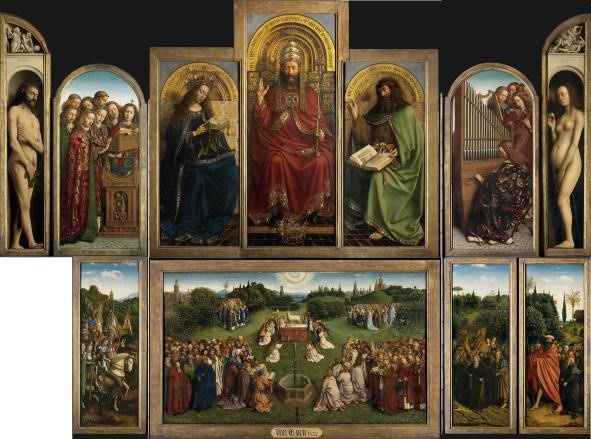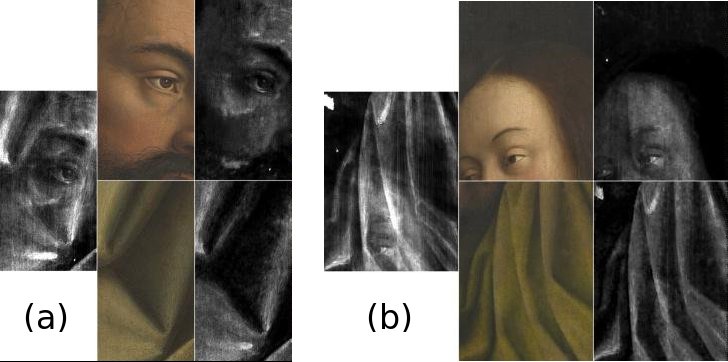ARTICT - Image Separation for Art Investigation
Challenge
X-radiographs (X-ray images) are a particularly valuable tool during the examination and restoration of paintings because these can help establish the condition of a painting (e.g., whether there are losses and damages that may not be apparent at the surface, perhaps because of obscuring varnish, overpainted layers, structural issues, or cracks in the paint) and the status of different paint passages (e.g., help to identify retouchings or fills).
However, interpreting X-ray images can be problematic because – due to the penetration ability of x-rays – these can contain features appearing on the front, back, or even within the painting.
A classic example relates to the well-known polyptych panel painting The Adoration of the Mystic Lamb (the Ghent Altarpiece), completed before 1432 by the brothers Hubert and Jan van Eyck (see Figs. 1 and 2), where X-ray images of outer wing panels contain features of the paintings appearing both on the front and back of the panel (see Fig. 3).
The challenge relates to the separation of the mixed X-ray images from the double-sided panels into separate X-ray images of corresponding (imagined) “one-sided” paintings.
Approach
Our team has developed a suite of entirely new self-supervised deep learning based approaches to tackle this X-ray image separation problem [1,2]. Our approach leverages readily available visible (RGB) images of the paintings on each side of the panel in order to decompose the mixed X-ray image onto its constituent (imagined) X-ray images (see Fig. 4).
Results obtained for details from the Adam and Eve panels of the Ghent Altarpiece demonstrate the efficacy of our proposed approaches [1,2] in relation to previous ones [3,4]. See Figs. 5a and 5b.





Other Use-Cases
Our team anticipates our proposed self-supervised deep learning based approaches can be adapted to tackle other related image separation challenges. These include the decomposition of a variety of mixed image modalities that contain various features present within a painting such as underdrawing and other pentimenti, or concealed designs.
Representative Publications
[1] Z. Sabetsarvestani, B. Sober, C. Higgitt, I. Daubechies, and M. R. D. Rodrigues. Artificial intelligence for art investigation: Meeting the challenge of separating x-ray images of the Ghent Altarpiece. Science Advances, 2019.
[2] W. Pu, B. Sober, N. Daly, C. Higgitt, I. Daubechies, M. R. D. Rodrigues. A connected auto-encoders based approach for image separation with side information: with applications to art investigation. IEEE International Conference on Acoustics, Speech and Signal Processing, 2020.
[3] Z. Sabetsarvestani, F. Renna, F. Kiraly and M. R. D. Rodrigues. Source Separation with Side Information Based on Gaussian Mixture Models With Application in Art Investigation. IEEE Transactions on Signal Processing, 2020.
[4] N. Deligiannis, J. F. C. Mota, B. Cornelis, M. R. D. Rodrigues, and I. Daubechies. Multi-Modal Dictionary Learning for Image Separation With Application In Art Investigation. IEEE Transactions on Image Processing, 2016.
Representative Media Coverage
Hidden works of Goya, Van Gogh and Van Eyck could be discovered using artifical intelligence - The Telegraph
Forget The Future, AI Will Take Us Back To The Past - Forbes